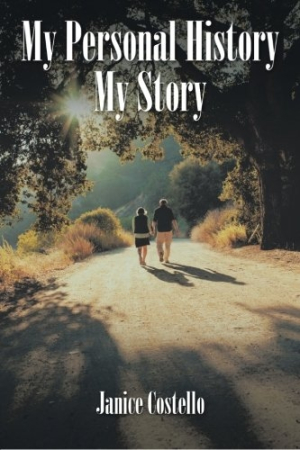
My Personal History, My Story
Costello leads by example in this writing handbook, with personal stories that are crisp and evocative.
In her slim but entertaining My Personal History, My Story, Janice Costello shares a series of vignettes from her life to show beginning writers how to develop their own creative writing skills.
The facts of Costello’s life are pieced together through her poignant writings, which cover her childhood years on an Australian produce farm through to her marriage and the birth of her three sons. When she became a single parent after her husband’s death, she had to fight to rediscover herself.
Costello’s background comes through in her responses to her own mini-assignments—prompts such as “How have you coped with a mishap in your life?” which leads to a story about a time she locked herself out of her car. She draws on her own personal life events to demonstrate a variety of these writing prompts. It’s interesting to see how she develops her stories based on very basic and limited guidelines. The results are intended to serve as one kind of example for would-be writers. The book does fulfill this purpose, though its movements between genres are initially confusing.
The author follows her own advice to be specific rather than general in details, and this makes for very enjoyable reading, especially when she writes of her formative years. Her stories aren’t told in chronological order, but details make it easy to piece together relationships. Some pivotal moments, including her husband’s death, appear only in passing, though.
The writing in these vignettes is crisp and wonderful to visualize, as with a description that comes from sitting around a campfire: “We listened to the crackle of flames as they devoured the dry wood … the angry fire spat, sizzled, and hissed.” An understated sense of humor also shines through, and Australian slang adds context. Errors with grammar, punctuation, and word usage make for uneven reading.
Costello’s writing advice is usually basic, such as how to use verbs and adjectives to one’s advantage, but will be useful to beginners. Later advice goes more into depth, covering writing devices such as rhythm and the use of metaphors.
Several memorable poems accentuate the text; the lack of attribution to a specific author makes it hard to determine whether they are original works or not. The book is dotted with feel-good quotes, which are a welcome addition to Costello’s bumpy journey to self-discovery.
This book is recommended for those who would like to examine some helpful examples that serve as a brief introduction into the creative writing process, in addition to those who simply enjoy reading about the life stories of others.
Reviewed by
Robin Farrell Edmunds
Disclosure: This article is not an endorsement, but a review. The publisher of this book provided free copies of the book and paid a small fee to have their book reviewed by a professional reviewer. Foreword Reviews and Clarion Reviews make no guarantee that the publisher will receive a positive review. Foreword Magazine, Inc. is disclosing this in accordance with the Federal Trade Commission’s 16 CFR, Part 255.

